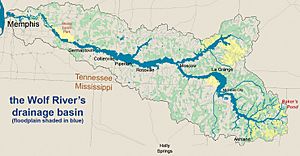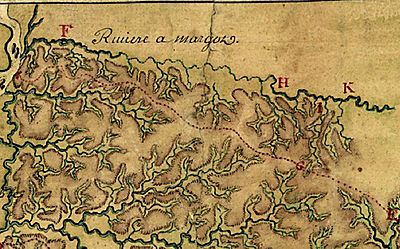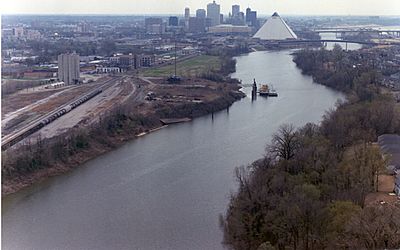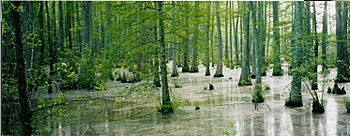Wolf River (Tennessee) facts for kids
Quick facts for kids Wolf River |
|
|---|---|
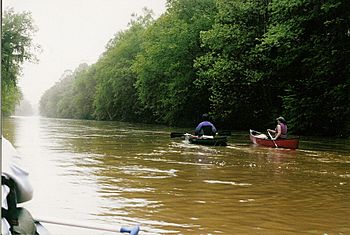
Wolf River in Germantown
|
|
| Country | United States |
| Physical characteristics | |
| Main source | Baker's Pond, Holly Springs National Forest, near Walnut, Mississippi 540 ft (160 m) 34°56′36″N 89°01′55″W / 34.94333°N 89.03194°W |
| River mouth | Mississippi River at Downtown Memphis, Tennessee 210 ft (64 m) 35°10′57″N 90°03′25″W / 35.18250°N 90.05694°W |
| Length | 90 mi (140 km) |
| Basin features | |
| Basin size | 889 sq mi (2,300 km2) |
The Wolf River is a 105-mile-long (169 km) river in western Tennessee and northern Mississippi. It flows into the mighty Mississippi River. The area where the Wolf River meets the Mississippi River became the city of Memphis, Tennessee.
Scientists believe the Wolf River is about 12,000 years old. It was formed by water from melting Midwestern glaciers. This water carved its way through the soft soil of the region. The Wolf River starts in the Holly Springs National Forest in Benton County, Mississippi. It then flows northwest into Tennessee before joining the Mississippi River north of downtown Memphis.
Over the years, people have worked hard to protect the Wolf River. In 1985, the Wolf River Conservancy was started to stop plans for digging up more of the riverbed. In 1997, the river was named an American Heritage River by the President. This special honor recognized its importance. The river helps prevent floods, provides homes for wildlife, offers fun outdoor activities, and gives us clean drinking water.

Contents
Where the Wolf River Flows
The Wolf River begins at Baker's Pond in the Holly Springs National Forest in Benton County, Mississippi. It then flows northwest into Tennessee. The river drains a large part of Memphis and northern Shelby County, Tennessee. Finally, it empties into the Mississippi River near Mud Island, just north of downtown Memphis.
Towns Along the River
Here are some of the cities and towns the Wolf River passes through, from its start to its end:
- Ashland, Mississippi
- Canaan, Mississippi
- Michigan City, Mississippi
- La Grange, Tennessee
- Moscow, Tennessee
- Rossville, Tennessee
- Piperton, Tennessee
- Collierville, Tennessee
- Germantown, Tennessee
- Bartlett, Tennessee
- Raleigh (now part of Memphis)
- Memphis, Tennessee
Wildlife and Plants of the Wolf River
The Wolf River area is home to many different animals. You might see deer, otters, mink, bobcats, foxes, and coyotes. There are also turkeys and many kinds of waterfowl. The river is full of reptiles, amphibians, and aquatic life. Sometimes, migrating birds like osprey, great egrets, and bald eagles can be seen along the river.
The forests along the Wolf River have some very old and large trees. One Tupelo Gum tree is 17 feet (5.2 m) around! Other trees include green ash, red maple, swamp chestnut oak, blackgum, and the tall bald cypress.
Beautiful flowering plants also grow here. These include cardinal flower, ironweed, swamp iris, false loosestrife, spatterdock, swamp rose, blue phlox, and spring cress.
The river is also home to twenty-five types of freshwater mussels. These mussels need very clean water to survive. This means they are easily harmed by pollution.
Thanks to community efforts and laws like the Clean Water Act, the river near Memphis is getting healthier. More and more of these plants and animals are now found in the city parts of the Wolf River.
History of the Wolf River

The Wolf River is an ancient stream. Its meeting point with the Mississippi River was important for many groups of people. These included the Chickasaw Native Americans, the French, the Spanish, and later, American settlers. All these groups had communities or forts there, which eventually grew into Memphis, Tennessee.
The Chickasaw people called this region "the land that leaks" because of its many rivers, including the Wolf. Around 400 CE, a big earthquake changed the path of another creek, Nonconnah Creek, making it flow directly into the Mississippi River instead of the Wolf.
The Mississippian culture lived in this area until about the 1500s. We know this from mound sites they built and from stories told by explorers like Hernando de Soto. Later, the Chickasaw nation settled in northern Mississippi, western Tennessee, and eastern Arkansas.
In 1682, French explorer Robert Cavelier de La Salle claimed the land near the Wolf River's mouth for France. The French gave the river different names, like Rivière de Mayot or Margot, Blackbird River, and Rivière du Loup. "Loup" means "Wolf" in French. It's thought that the name came from a Mahican Indian guide who disappeared along the river. The Mahicans were also known as "The Wolves." Both the English and the Chickasaw later called the river "Wolf" or "Nashoba," which means wolf in their languages.
In 1795, the Spanish government built Fort San Fernando de las Barrancas near the Wolf River's mouth. They were worried about American activities in the area. However, the fort was taken down in 1797 after a treaty. Spanish documents called the river "Las Casas."
In the early 1800s, the Wolf River was declared open for boats from Memphis to La Grange, Tennessee. Money was set aside to clear obstacles for travel. In 1888, Memphis stopped using the Wolf River for drinking water. Instead, the city started using water from underground aquifers, which are still used today. The Wolf River's watershed helps refill these aquifers.
By 1960, the Wolf River near its mouth was dammed because of its bad smell. Its flow was changed to go into the Mississippi River north of Mud Island. The part of the Wolf River below this change became a calm harbor called Wolf River Harbor. This harbor separates Mud Island from the Memphis "mainland."
In 1970, pollution from drainage, sewage, and factories caused scientists to say the river was "dead" around Memphis.
In 1985, the Wolf River Conservancy was created. This group of people wanted to protect the river and stop more digging. In 1995, a special part of the river called the "Ghost River" was saved from being sold for timber. This was thanks to a team effort by different agencies and local activists.
In 1997, the river was named an American Heritage River. This was part of a special program by the United States Environmental Protection Agency. Sadly, in that same year, musician Jeff Buckley accidentally drowned in the Wolf River while swimming in Memphis.
In 2005, the Wolf River Restoration Project began. This project, led by the U.S. Army Corps of Engineers, aimed to stop fast erosion near Collierville, Tennessee.
Benefits of the Wolf River
The Wolf River Conservancy explains that the Wolf River helps the Mid-South in four important ways:
- Flood and Erosion Control: When it rains a lot, the Wolf River's floodplains and wetlands act like sponges. They hold extra floodwaters temporarily. If these areas are built on, the river loses its natural way to release water. This can make the river flow faster and cause higher floods. Without enough floodplain, floods and the erosion they cause can damage property and roads, and even threaten lives.
- Water Quality: The Memphis area gets its drinking water from a very clean underground aquifer beneath the Wolf River Basin. The river's wetlands help keep this water clean. They hold water long enough for it to soak into the ground. They also act as natural filters, cleaning polluted water before it reaches the aquifer.
- Wildlife Habitat: The Wolf River provides a home for many different animals and birds. As mentioned before, you can see migrating osprey, great egrets, and bald eagles along the river.
- Low-Impact Recreation: Even though cities are all around the Wolf River, its wetlands and trails offer beautiful wilderness experiences. People can enjoy nature from the Holly Springs National Forest all the way to downtown Memphis. Hikers, runners, cyclists, and paddlers can enjoy the outdoors on or near the river every day.
Images for kids
See also
 In Spanish: Río Wolf (Tennessee) para niños
In Spanish: Río Wolf (Tennessee) para niños


